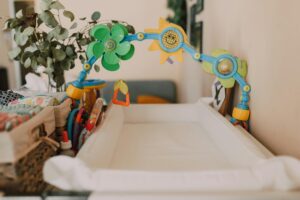By: MARY JO PITZL | ARIZONA REPUBLIC
Nikolas Crosby-Garbotz called 911 because he thought his infant daughter was having a seizure.
He got medical assistance. But he also got an allegation of child abuse from the state Department of Child Safety, a criminal indictment and a 2 ½-year court fight over shaken-baby syndrome.
A state Supreme Court ruling ended his troubles earlier this month, when the justices decided a criminal case charging him with child abuse was moot because Juvenile Court had already determined he did not abuse his daughter.
Some observers believe the ruling could embolden families to fight charges against them in Juvenile Court, something many don’t do because of the cost and complexity of dealing with a child-removal case. But those factors could make this case a “unicorn,” as Crosby-Garbotz’s attorney put it.
A first for the court
Although it’s not uncommon for child-abuse or neglect cases to spill into the criminal realm, it’s rare for someone to fight the charges to the state’s highest court.
Chief Justice Scott Bales, who wrote the majority opinion in the 4-3 decision, stated the case was a first for the Arizona Supreme Court.
“Nick is such a unique case because he could bring experts in to debate the science.” – Markus Risinger, Nickolas Crosby-Garbotz’s lawyer.
Markus Risinger, who represented the Tucson father, said he thinks he knows why: It takes money, time and determination to fight a case in Juvenile Court.
Parents with limited resources who face charges in Juvenile Court usually focus on doing whatever DCS requires to get their kids back, rather than fighting it out in court — especially if they face the risk of a criminal charge, Risinger said.
“Nik is such a unique case because he could bring experts in to debate the science,” he said of the defense strategy. Crosby-Garbotz and his attorneys challenged the state’s assertion that the infant’s injuries were not accidental and likely a result of shaken-baby syndrome.
DCS sees child abuse
For Crosby-Garbotz, the allegation of abuse in July 2016 was surprising and infuriating.
“There was no doubt in my mind that I was going to fight this,” he said.
DCS took temporary custody of the baby while she was in the hospital. She was treated for bleeding in both eyes, a splitting of the layers of the eyes and a subdural hematoma — conditions that led DCS to conclude the baby had been violently shaken.
In a petition filed in Pima County Juvenile Court, DCS alleged child abuse by Crosby-Garbotz and that his wife, Lacy, had failed to protect their then 5-month-old child from abuse.
The family fights back
The couple moved into separate living quarters so the baby could stay in the mom’s care. DCS would not allow Crosby-Garbotz to be alone with the child. He was limited to four hours a week of visits supervised by a DCS contractor.
To get back with his family, Crosby-Garbotz said DCS insisted that he first accept the findings of their medical experts.
“Family reunification, in their eyes, could only be attained if someone admits to a crime,” he said.
The couple lawyered up, hiring a Phoenix firm with a track record of fighting DCS cases.
Overlapping cases
In November 2016, Pima County Juvenile Court started a dependency trial on the child-abuse allegation. The trial dragged into February 2017, slowed by schedule conflicts among the experts both sides brought in to testify to the nature of the baby’s injuries.
“I had missed her first steps, her first thanksgiving, her first Christmas. You can’t ever get that back.” – Nicholas Crosby-Garbotz
Meanwhile, 10 days before Christmas 2016, Crosby-Garbotz opened his mail to find a grand-jury indictment for criminal child abuse. He was surprised; he thought criminal court would wait for a decision in the Juvenile Court case.
That decision came March 8, 2017. Juvenile Court Judge Deborah Pratte found the state did not prove by a preponderance of the evidence that Crosby-Garbotz had harmed his child. The judge concluded the baby’s injuries were more likely due to “a chronic subdural hematoma that was aggravated when she bumped her head on her crib,” according to the court records.
Pratte dismissed the dependency case and returned the baby to both parents’ care. DCS did not appeal. The agency declined comment on why, if it felt there was a criminal offense, it did not appeal Pratte’s decision.
After eight months, Crosby-Garbotz could again be with his wife and child. But, he said, the cost of those eight months was “immeasurable.”
“I had missed her first steps, her first Thanksgiving, her first Christmas,” he said of the baby. “You can’t ever get that back.”
One decision prevails
With the Juvenile Court’s finding, Crosby-Garbotz and his attorneys asked the criminal court to reconsider the child-abuse allegation. They were denied.
That triggered a series of appeals that reached the state Supreme Court.
The argument revolved around the question of whether a concept called “issue preclusion” shielded Crosby-Garbotz from being tried twice for the same allegation.
The court determined that since the child-abuse claim had been litigated in Juvenile Court and the claim failed to meet the standard that a preponderance of the evidence showed guilt, there was no need for a criminal trial.
A close decision
Bales ordered Pima County Superior Court to dismiss the criminal charge against Crosby-Garbotz. Justices Clint Bolick, Robert Brutinel and John Pelander joined in the opinion.
Justice Ann Timmer wrote the dissent. She argued the Juvenile Court could not cancel out the ability of the criminal court to act, citing different standards of review for the two courts. She was joined by Justices Andrew Gould and John R. Lopez IV.
Risinger, the attorney, said he doesn’t think the ruling will change much at the intersection between juvenile and criminal courts because most parents can’t afford to fight a juvenile allegation.
But others speculate the ruling could embolden families to contest the allegations, since the Juvenile Court tends to be more favorable to families than criminal court.
Two weeks after the ruling, Pima County prosecutors asked the Supreme Court to reconsider its decision. They said the opinion did not adequately take into account victims’ rights, nor did it weigh what they said is the negative effect on public policy.
On Friday, the court declined to reconsider.
A win, but some losses
The little girl at the center of this case turned 3 days before the Supreme Court ruling. Her father says she is a “remarkable little girl” and has shown no lingering effects from the injury she had as an infant.
The couple has since added another child to the family.
The case cost him an estimated $200,000. He lost his real-estate license because of the criminal indictment. DCS tried to add him to the Central Registry, a private list the state maintains of people with child neglect and abuse allegations, but he successfully fought it.
Although free of any charge, Crosby-Garbotz says his daughter’s medical record paints him as child abuser. He worries what she would think if she saw it someday.
“What does that do to a relationship between a father and a child?” he asked. “How does that (record) get changed?”
Reach the reporter at [email protected] and follow her on Twitter @maryjpitzl.
Support local journalism. Subscribe to azcentral.com today.
To read this article on the Arizona Republic website, click here.


